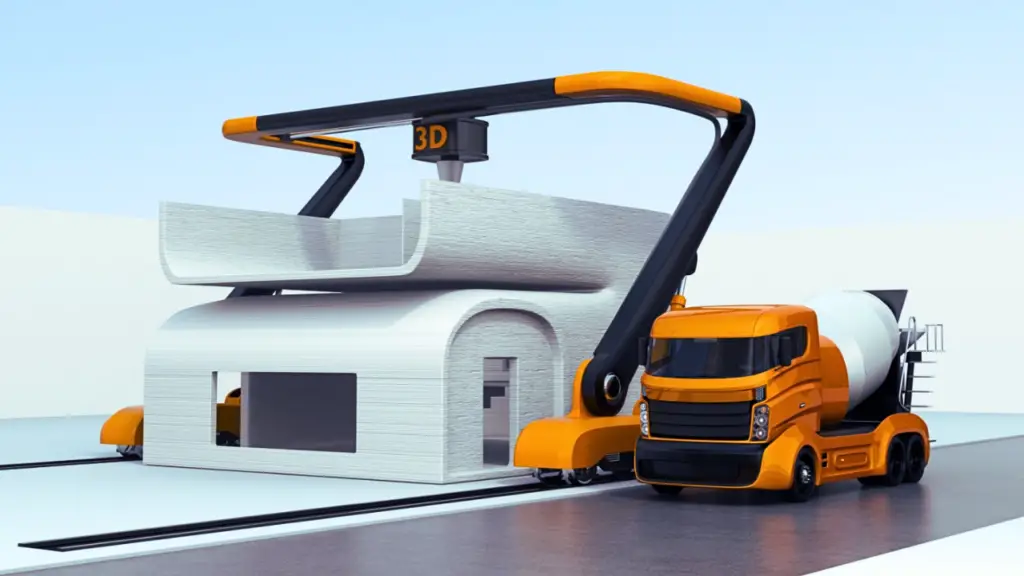
3D printing is swiftly becoming one of the most intriguing and disruptive technologies in the real estate sector. Though currently more expensive and relatively unpolished, the concept of building structures on-site through 3D printing holds the potential to revolutionise the industry.
Current Applications and Future Potential
Presently, 3D printing is utilised in real estate primarily for creating prototypes and models. However, as the technology evolves, it promises to fundamentally transform traditional construction practices by “printing” actual real estate properties.

How 3D Printing Works
3D printing involves creating physical objects by depositing materials layer by layer, based on a digital model. A complete 3D printing setup includes:
- Software: A digital design blueprint.
- Hardware: The 3D printer itself.
- Materials: The raw substances used to build the object.
The digital model is sliced into layers, allowing the 3D printer to interpret and construct the object layer by layer according to the design specifications.
While the structures built so far have been elementary in design, many countries have expressed a strong interest in the technology as a way of solving affordable housing issues, primarily in developing countries. India is one such country which is desperately looking for a solution to its housing shortage.
The disruptive nature of 3D printing is not only affecting the way real estate is being built, but also the consumption of materials with zero waste. Segments like retail, warehousing, and industrial real estate are likely to see compelling changes in demand and necessity. In the upcoming decade, it is highly likely that people will 3D print models or, more likely, houses on their own, given the evolution of such technologies and tools.
Right now, 3D printing is expensive for small-scale projects and still in its nascent stages. But, after witnessing the growth of e-commerce in the recent past, it is indicative that, a growing trend can unexpectedly become a way of life.
3D Printing Disruption
Currently, the world is facing a major overpopulation and housing crisis. But, we have also come up with phenomenal breakthroughs and innovations on the digital front, taking our possibilities and capabilities to new heights.

When facing huge roadblocks, we tend to come up with even greater solutions. In this backdrop, the industry has come up with the invention of 3D printing, which is set to impact many sectors of life. It will transform and alter the way construction has been done for over a thousand years.
Numerous companies and start-ups from the Netherlands, USA, China, Russia, etc. have started working on and utilizing the possibilities of 3D printing. They have started modeling and constructing cheaper, more complex, and more efficient buildings. The speed with which they are able to mobilize and innovate in this field is mind-boggling. The two major frontlines of this technological disruption are speed and cost.
Speed

The rate at which a house can be 3D printed is overwhelming. Traditionally, a two-story building takes around 6-7 months to complete with conventional methods. However, in 2016, a Chinese construction company, HuaSheng Tengda, 3D printed a 400-square-meter, two-story house in just 45 days.
Later, in 2017, Apis Cor, a San Francisco-based housing start-up, collaborated with PIK Group, a Russian company, to construct a 400-square-foot circular house in just one day. When comparing the rate at which these developments are taking place, it is not hard to understand the scope of potential disruption.
Cost
Apis Cor’s 24-hour circular house was built for just under $10,000. These 3D printed homes considerably cut back on material costs as well as the cost of waste management.
Moreover, it comes with minimal costs of labor, machine procurement, and inventory. Additionally, numerous other companies are exploring even cheaper and more labor-intensive sustainable materials and methods to further shrink the costs.
Advantages Of 3D Printing
- Facilitating construction in dense inaccessible areas due to the reduction in the sprawl of machines and materials.
- Enabling the construction of complex structures with unusual shapes and customizations.
- Constructing waste-free buildings by eliminating the practice of cutting out waste elements.
- 3D printing optimizes the construction speed to another level. The time taken through conventional practices generally takes around 6-7 months at the least, whereas a similar house can be 3D printed in a matter of day or two.
- The cost of construction reduces significantly due to rebate in raw materials, wastage, labours, and machines. This will open up avenues of affordable housing for the homeless.
- There is also a substantial cutback on environmental pollution, carbon footprint, and waste dumping. Curtailing the dumping of construction waste at landfills will be one of the biggest boons of this technology.
The Road Ahead
The most exciting aspect of 3D printing is the expanding possibilities as more companies adopt this technology. In the near future, we can anticipate multi-story buildings being constructed at unprecedented speeds and costs.
The potential of 3D printing in the real estate market is limitless, unaffected by traditional barriers of size and scope. As developed countries continue to advance in this field, it’s time for Indian real estate players to seize this emerging trend and capitalize on the opportunities it presents.
With its promise of revolutionizing construction methods, reducing costs, and minimizing environmental impact, 3D printing stands poised to transform the real estate industry on a global scale.



